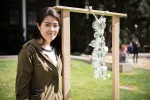One man’s trash is another Bruin’s treasure – the proof is in campus sculptures fashioned from old T-shirts, dental floss and mason jars.
On Monday, students in the design media arts class “Word + Image” presented their artwork made entirely out of trash found on campus. Rebeca Mendez, the course’s instructor, said the class focused on using art to address issues surrounding anthropogenic climate change. The projects – displayed in front of the Broad Art Center – furthered awareness of the world’s excess waste and are inspired by the Zero Waste by 2020 initiative at UCLA, she said.
“The insanity of the overconsumerism that we have as a species, as humans, and specifically in the first world, that we can make so much trash – our earth cannot sustain any more,” Mendez said.
To plan their sculptures, Mendez said the students went “waste-mining.” Some students wore safety gear while they sifted through a day’s worth of trash from Powell Library, while others utilized their own waste, she said. Their finds, which included plastic cutlery and bags, often directly influenced the message about climate change they tried to convey, Mendez said. If a student used a large amount of e-waste and shredded paper, Mendez said they could create a sculpture or use lettering to convey a message about the excess waste they found. The goal was to have the students pick a message and use the material they found to portray it, she said.
“(Trash) can only be recycled one or two times before it ends up back in the landfill; we’re really slowing down the process of it going to the landfill,” Mendez said. “The most overarching message is to … refuse items that cannot be repurposed and reused.”
[RELATED: Renewable Energy Association’s SWAP Meet to promote sustainability]
The students were instructed not to generate additional waste – every aspect of their project had to come from campus trash, said graduate student and the course’s teaching assistant, Zeynep Abes. To hold their sculptures together, many students used thread made out of repurposed dental floss, Abes said.
“It was very much about repurposing all kinds of objects and waste to make the sculptures, so they’re made completely out of waste; students have created these compelling and meaningful messages out of them,” Abes said.
Students used junk to spell out their intended message in some of the sculptures, Abes said. Fourth-year design media arts student Mina Malloy said she utilized typography to inspire viewers to reuse single-use items. Her work featured mason jars and letters she made out of plastic cups wrapped in fabric. Combined, the letters spelled out a Japanese phrase meaning “too good to waste.” By connecting the individual pieces with single-use plastic products, Malloy said she hopes her piece led people to think critically about using such items.
[RELATED: MOCA curates annual student art exhibit featuring diverse subjects and styles]
Additionally, Malloy said the trash from the sculptures will continue to be repurposed on a larger stage after the works’ initial showing. Some of the students’ pieces were selected by Mendez to be displayed in the upcoming “Junk Battle!” exhibit at the Los Angeles County Museum of Art, Malloy said. But after that, it is the artist’s decision whether they want to keep their pieces or not – if they choose to dismantle the works, the trash will end up back where it began, she said.
“We’re making sculptures … but at the same time, it’s still trash and it will eventually end up in a landfill, so it’s not like we’re really making a difference in that sense, besides raising awareness,” Malloy said.
Simply making art out of trash is not going to fully achieve UCLA’s goal of eliminating waste by 2020, Malloy said. But by refurbishing garbage in unconventional and artistic ways, the students’ projects pointed to the reality of waste production and the abundant opportunities to repurpose items, she said.
“The idea that we’re trying to show is a lot of things that get trashed, or a lot of things that people consider waste, is not waste at all,” Abes said. “It’s just trying to educate them on different ways of sustainable living.”
